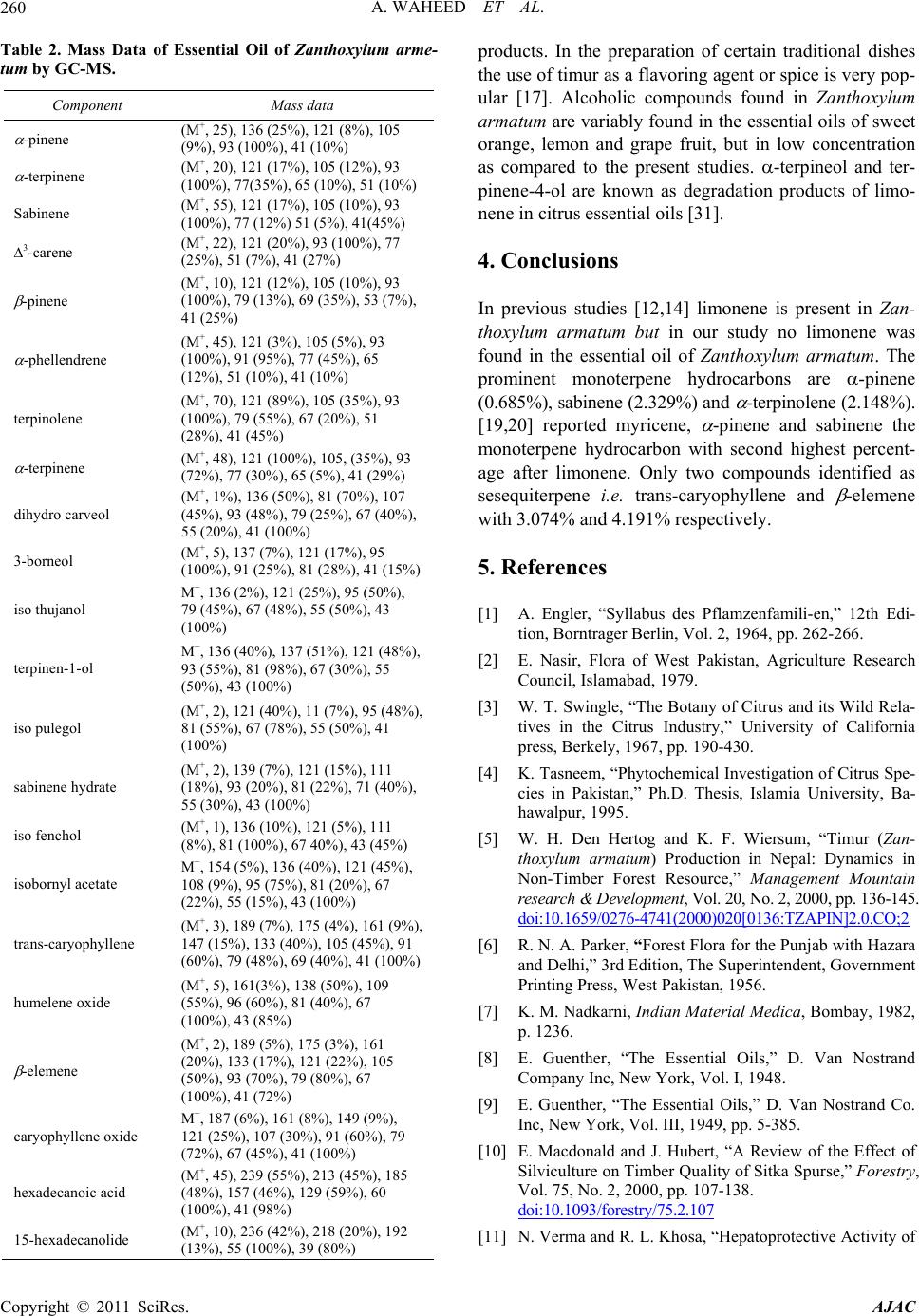
A. WAHEED ET AL.
260
Table 2. Mass Data of Essential Oil of Zanthoxylum arme-
tum by GC-MS.
Component Mass data
-pinene (M+, 25), 136 (25%), 121 (8%), 105
(9%), 93 (100%), 41 (10%)
-terpinene (M+, 20), 121 (17%), 105 (12%), 93
(100%), 77(35%), 65 (10%), 51 (10%)
Sabinene (M+, 55), 121 (17%), 105 (10%), 93
(100%), 77 (12%) 51 (5%), 41(45%)
3-carene (M+, 22), 121 (20%), 93 (100%), 77
(25%), 51 (7%) , 41 (27%)
-pinene (M+, 10), 121 (12%), 105 (10%), 93
(100%), 79 (13%), 69 (35%), 53 (7%),
41 (25%)
-phellendrene (M+, 45), 121 (3%), 105 ( 5%), 93
(100%), 91 (95%), 77 (45%), 65
(12%), 51 (10%), 41 (10%)
terpinolene (M+, 70), 121 (89%), 105 (35%), 93
(100%), 79 (55%), 67 (20%), 51
(28%), 41 (45%)
-terpinene (M+, 48), 121 (100%), 105, (35%), 93
(72%), 77 (30%), 65 (5%), 41 (29%)
dihydro carveol (M+, 1%), 136 (50%), 81 (70%), 107
(45%), 93 (48%), 79 (25%), 67 (40%),
55 (20%), 41 (100%)
3-borneol (M+, 5), 137 (7%), 121 (17%), 95
(100%), 91 (25%), 81 (28%), 41 (15%)
iso thujanol M+, 136 (2%), 121 (25%), 95 (50%),
79 (45%), 67 (48%) , 55 (50%), 43
(100%)
terpinen-1-ol M+, 136 (40%), 137 (51%), 121 (48%),
93 (55%), 81 (98%), 67 (30%), 55
(50%), 43 (100%)
iso pulegol (M+, 2), 121 (40%), 11 (7%), 95 (48%),
81 (55%), 67 (78%), 55 (50%), 41
(100%)
sabinene hydrate (M+, 2), 139 (7%), 121 (15%), 111
(18%), 93 (20%), 81 (22%), 71 (40%),
55 (30%), 43 (100%)
iso fenchol (M+, 1), 136 (10%), 121 (5%), 111
(8%), 81 (100%), 67 40%), 43 (45%)
isobornyl acetate M+, 154 (5%), 136 (40%), 121 (45%),
108 (9%), 95 (75%), 81 (20%), 67
(22%), 55 (15%), 43 (100%)
trans-caryophyllene (M+, 3), 189 (7%), 175 (4%), 161 (9%),
147 (15%), 133 (40%), 105 (45%), 91
(60%), 79 (48%), 69 (40%), 41 (100%)
humelene oxide (M+, 5), 161(3%), 138 (50%), 109
(55%), 96 (60%), 81 (40%), 67
(100%), 43 (85%)
-elemene
(M+, 2), 189 (5%), 175 (3%), 161
(20%), 133 (17%), 121 (22%), 105
(50%), 93 (70%), 79 (80%), 67
(100%), 41 (72%)
caryophyllene oxide M+, 187 (6%), 161 (8%), 149 (9%),
121 (25%), 107 (30%), 91 (60%), 79
(72%), 67 (45%), 41 (100%)
hexadecanoic acid (M+, 45), 239 (55%), 213 (45%), 185
(48%), 157 (46%), 129 (59%), 60
(100%), 41 (98%)
15-hexadecanolide (M+, 10), 236 (42%), 218 (20%), 192
(13%), 55 (100%), 39 (80%)
products. In the preparation of certain traditional dishes
the use of timur as a flavoring agent or spice is very pop-
ular [17]. Alcoholic compounds found in Zanthoxylum
armatum are variab ly found in the essential oils of sweet
orange, lemon and grape fruit, but in low concentration
as compared to the present studies. -terpineol and ter-
pinene-4-ol are known as degradation products of limo-
nene in citrus essential oils [31].
4. Conclusions
In previous studies [12,14] limonene is present in Zan-
thoxylum armatum but in our study no limonene was
found in the essential oil of Zanthoxylum armatum. The
prominent monoterpene hydrocarbons are -pinene
(0.685%), sabinene (2.329%) and
-terpinolene (2.148%).
[19,20] reported myricene,
-pinene and sabinene the
monoterpene hydrocarbon with second highest percent-
age after limonene. Only two compounds identified as
sesequiterpene i.e. trans-caryophyllene and
-elemene
with 3.074% and 4.191% respectively.
5. References
[1] A. Engler, “Syllabus des Pflamzenfamili-en,” 12th Edi-
tion, Borntrager Berlin, Vol. 2, 1964, pp. 262-266.
[2] E. Nasir, Flora of West Pakistan, Agriculture Research
Council, Islamabad, 1979.
[3] W. T. Swingle, “The Botany of Citrus and its Wild Rela-
tives in the Citrus Industry,” University of California
press, Berkely, 1967, pp. 190-430.
[4] K. Tasneem, “Phytochemical Investigation of Citrus Spe-
cies in Pakistan,” Ph.D. Thesis, Islamia University, Ba-
hawalpur, 1995.
[5] W. H. Den Hertog and K. F. Wiersum, “Timur (Zan-
thoxylum armatum) Production in Nepal: Dynamics in
Non-Timber Forest Resource,” Management Mountain
research & Development, Vol. 20, No. 2, 2000, pp. 13 6- 145.
doi:10.1659 /0276-4741(2000)020[0136:TZAPIN]2.0.CO;2
[6] R. N. A. Parker, “Forest Flora for the Punjab with Hazara
and Delhi,” 3rd Edition, The Superintendent, Government
Printing Press, West Pakistan, 1956.
[7] K. M. Nadkarni, Indian Material Medica, Bombay, 1982,
p. 1236.
[8] E. Guenther, “The Essential Oils,” D. Van Nostrand
Company Inc, New York, Vol. I, 1948.
[9] E. Guenther, “The Essential Oils,” D. Van Nostrand Co.
Inc, New York, Vol. III, 1949, pp. 5-385.
[10] E. Macdonald and J. Hubert, “A Review of the Effect of
Silviculture on Timber Quality of Sitka Spurse,” Forestry,
Vol. 75, No. 2, 2000, pp. 107-138.
doi:10.1093 /forestry/75.2.107
[11] N. Verma and R. L. Khosa, “Hepatoprotective Activity of
Copyright © 2011 SciRes. AJAC